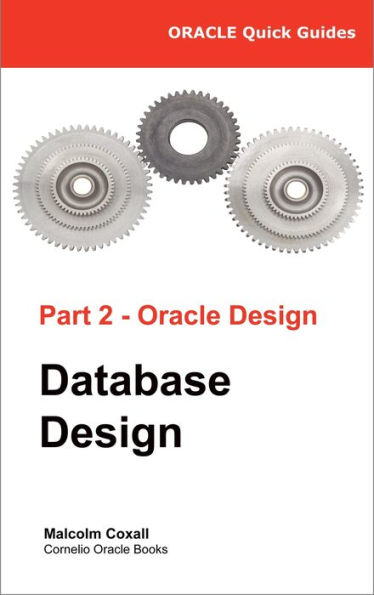This is Part 2 of a series of quick learning guides for Oracle designers, developers and managers. Part 2 introduces completely new entrants to concepts of Oracle database analysis and design, database normalisation, the logical datamodel, E-R modelling and diagrams, logical to physical transformation in Oracle Designer, physical database design, de-normalization, database design for performance, and building a physical database from a server model.
These guides are designed to rapidly deliver key information about Oracle to the following audience groups:
- Project Managers and Team Leaders who are new to Oracle and need rapid access to strategic information about the Oracle design and development environment.
- Business Analysts, Designers and Software developers who are new to Oracle and need to make first steps in gaining a detailed understanding of the design and development issues involved in Oracle.
Part 2 assumes that the reader has a basic knowledge of the relational model and a basic understanding of logical and physical design concepts. The contents of Part 2 include the following subject headings:
Preface and Audience
1. The Analysis phase - Separating Functional and Database Design
2. Introduction to Datamodelling and Database Design: Logical and Physical concepts of design
3. Practical Logical Design - Data-modelling
4. Practical Logical Design using Oracle Designer
5. Moving from the Logical to the Physical design
6. Practical Physical Design (using Oracle Designer)
7. Designing a database for Performance
8. Building the physical database from Designer
9. Managing Changes during development
10. Glossary of Terms
1115381120
These guides are designed to rapidly deliver key information about Oracle to the following audience groups:
- Project Managers and Team Leaders who are new to Oracle and need rapid access to strategic information about the Oracle design and development environment.
- Business Analysts, Designers and Software developers who are new to Oracle and need to make first steps in gaining a detailed understanding of the design and development issues involved in Oracle.
Part 2 assumes that the reader has a basic knowledge of the relational model and a basic understanding of logical and physical design concepts. The contents of Part 2 include the following subject headings:
Preface and Audience
1. The Analysis phase - Separating Functional and Database Design
2. Introduction to Datamodelling and Database Design: Logical and Physical concepts of design
3. Practical Logical Design - Data-modelling
4. Practical Logical Design using Oracle Designer
5. Moving from the Logical to the Physical design
6. Practical Physical Design (using Oracle Designer)
7. Designing a database for Performance
8. Building the physical database from Designer
9. Managing Changes during development
10. Glossary of Terms
Oracle Quick Guides - Part 2 - Oracle Database Design
This is Part 2 of a series of quick learning guides for Oracle designers, developers and managers. Part 2 introduces completely new entrants to concepts of Oracle database analysis and design, database normalisation, the logical datamodel, E-R modelling and diagrams, logical to physical transformation in Oracle Designer, physical database design, de-normalization, database design for performance, and building a physical database from a server model.
These guides are designed to rapidly deliver key information about Oracle to the following audience groups:
- Project Managers and Team Leaders who are new to Oracle and need rapid access to strategic information about the Oracle design and development environment.
- Business Analysts, Designers and Software developers who are new to Oracle and need to make first steps in gaining a detailed understanding of the design and development issues involved in Oracle.
Part 2 assumes that the reader has a basic knowledge of the relational model and a basic understanding of logical and physical design concepts. The contents of Part 2 include the following subject headings:
Preface and Audience
1. The Analysis phase - Separating Functional and Database Design
2. Introduction to Datamodelling and Database Design: Logical and Physical concepts of design
3. Practical Logical Design - Data-modelling
4. Practical Logical Design using Oracle Designer
5. Moving from the Logical to the Physical design
6. Practical Physical Design (using Oracle Designer)
7. Designing a database for Performance
8. Building the physical database from Designer
9. Managing Changes during development
10. Glossary of Terms
These guides are designed to rapidly deliver key information about Oracle to the following audience groups:
- Project Managers and Team Leaders who are new to Oracle and need rapid access to strategic information about the Oracle design and development environment.
- Business Analysts, Designers and Software developers who are new to Oracle and need to make first steps in gaining a detailed understanding of the design and development issues involved in Oracle.
Part 2 assumes that the reader has a basic knowledge of the relational model and a basic understanding of logical and physical design concepts. The contents of Part 2 include the following subject headings:
Preface and Audience
1. The Analysis phase - Separating Functional and Database Design
2. Introduction to Datamodelling and Database Design: Logical and Physical concepts of design
3. Practical Logical Design - Data-modelling
4. Practical Logical Design using Oracle Designer
5. Moving from the Logical to the Physical design
6. Practical Physical Design (using Oracle Designer)
7. Designing a database for Performance
8. Building the physical database from Designer
9. Managing Changes during development
10. Glossary of Terms
3.04
In Stock
5
1

Oracle Quick Guides - Part 2 - Oracle Database Design

Oracle Quick Guides - Part 2 - Oracle Database Design
Related collections and offers
3.04
In Stock

Product Details
| BN ID: | 2940149597000 |
|---|---|
| Publisher: | Malcolm Coxall - Cornelio Books |
| Publication date: | 05/13/2013 |
| Series: | Doctor Who - Short Trips #5.11 , #2 |
| Sold by: | Barnes & Noble |
| Format: | eBook |
| File size: | 500 KB |
About the Author
From the B&N Reads Blog
